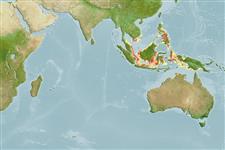>
Pleuronectiformes (Flatfishes) >
Soleidae (Soles)
Etymology: Aseraggodes: Greek, aggos, -eos, -ous = vessel, uterus, carapace of a crab + Greek, aseros, -a, -on = to remove the appetite (Ref. 45335); suzumotoi: Named for Arnold Y. Suzumoto, collection manager in Ichthyology at the Bishop Museum.
Eponymy: Arnold Y Suzumoto (d: 1951) is Ichthyology Collections Manager at the Bishop Museum, Hawaii. [...] (Ref. 128868), visit book page.
More on authors: Randall & Desoutter-Meniger.
Environment: milieu / climate zone / depth range / distribution range
Ecología
marino asociado a arrecife; rango de profundidad 4 - 26 m (Ref. 75879). Tropical
Distribución
Países | Áreas FAO | Ecosistemas | Ocurrencias, apariciones | Point map | Introducciones | Faunafri
Western Pacific: Indonesia.
Tamaño / Peso / Age
Maturity: Lm ? range ? - ? cm
Max length : 7.5 cm SL (female)
Short description
Claves de identificación | Morfología | Morfometría
Radios blandos dorsales (total) : 66 - 72; Radios blandos anales: 46 - 50; Vértebra: 34 - 35.
Collected by handnet from dar silty sand and in a cave at 6 m, Observed to form dense aggregation (Ref. 75879).
Life cycle and mating behavior
Madurez | Reproducción | Puesta | Huevos | Fecundidad | Larva
Randall, J.E. and M. Desoutter-Meniger, 2007. Review of the soles of the genus Aseraggodes (Pleuronectifornes: Soleidae) from the Indo-Malayan region, with descriptions of nine new species. Cybium 31(3):301-331. (Ref. 75879)
IUCN Red List Status (Ref. 130435: Version 2024-2)
Threat to humans
Harmless
Human uses
Herramientas
Special reports
Download XML
Fuentes de Internet
Estimates based on models
Preferred temperature (Ref.
123201): 28.5 - 29.2, mean 28.8 °C (based on 231 cells).
Phylogenetic diversity index (Ref.
82804): PD
50 = 0.5000 [Uniqueness, from 0.5 = low to 2.0 = high].
Bayesian length-weight: a=0.00977 (0.00466 - 0.02049), b=3.07 (2.90 - 3.24), in cm total length, based on LWR estimates for this (Sub)family-body shape (Ref.
93245).
Nivel trófico (Ref.
69278): 3.5 ±0.5 se; based on size and trophs of closest relatives
Resiliencia (Ref.
120179): Alto, población duplicada en un tiempo mínimo inferior a 15 meses (Preliminary K or Fecundity.).
Fishing Vulnerability (Ref.
59153): Low vulnerability (10 of 100).
